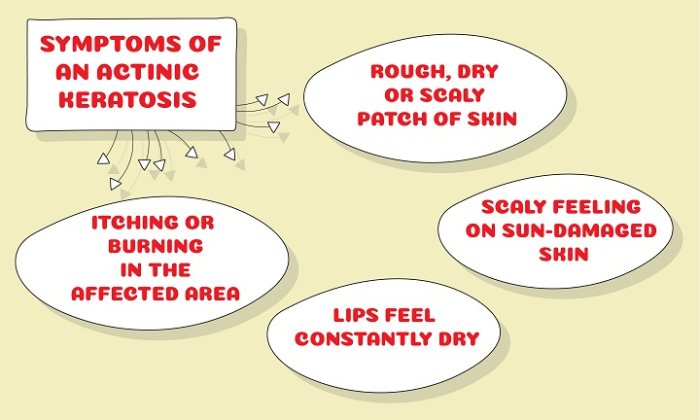
 Data Structure
Data Structure Networking
Networking RDBMS
RDBMS Operating System
Operating System Java
Java MS Excel
MS Excel iOS
iOS HTML
HTML CSS
CSS Android
Android Python
Python C Programming
C Programming C++
C++ C#
C# MongoDB
MongoDB MySQL
MySQL Javascript
Javascript PHP
PHP
- Selected Reading
- UPSC IAS Exams Notes
- Developer's Best Practices
- Questions and Answers
- Effective Resume Writing
- HR Interview Questions
- Computer Glossary
- Who is Who
Actinic Keratosis
Actinic keratosis is the skin lesions that occur because of exposure to the sun directly for a longer duration. The risk of developing these is directly proportional to the amount and duration of sun exposure. These are more commonly seen in old age people, fair skin individuals, males, and in immunosuppressive patients. When the skin is exposed to UV radiation for a longer duration it causes various changes in the skin layer, altering the regular pathways of cell growth and causing the inflammation.
Actinic keratosis is also called senile keratosis or solar keratosis. These are the most common skin disorders which present as red, white, or brown lesions with scaling having irregular borders on the sun-exposed parts. More commonly seen on the nose, forehead, bald scalp, tops of ears, back of hands, forearms, upper chest, upper lip, and back of the neck.
As these are the potential to cause skin cancer, early detection and treatment is important.

Actinic Keratosis: Causes
The main causes for the occurrence of actinic keratosis include ?
Prolonged exposure to the sun: The amount and duration of the exposure are directly proportional to the amount of the damage. More the exposure more the damage.
Weak immune system: Patient having weak immune system develops it early compared to the normal individuals
Fair skin types
Actinic Keratosis: Symptoms
The main symptoms of actinic keratosis include ?
The skin lesions are present over the sun-exposed areas
Presents either as a lesion which reddish, whitish or brownish in color with irregular borders
Rough, dry skin and scaliness is present
Minor bleeding is also seen
Painful when the fingers are drawn over them
Itching and burning sensation is present in the area of the lesion

Actinic Keratosis: Risk Factors
Age: elderly people are more prone to develop actinic keratosis, usually above the age of 50 years.
Fair skin types
Longer exposure to the sun
Patients with a weak immune system such as patients having cancer, or HIV, on immunosuppressives, who have undergone chemotherapy or radiotherapy
Geographical location: People staying in equatorial areas are more prone
History of actinic keratosis or any skin malignancy
Actinic Keratosis: Diagnosis
The diagnosis of actinic keratosis is done based on the presentation and some of the investigation to confirm the diagnosis which includes ?
Skin Biopsy ? A shave or punch biopsy can be taken and sent for histopathological examination. Histologically it shows disorganization of the epidermal cell layer, acanthosis, reduced granular cell layer, parakeratosis, and hyperkeratosis.
Dermascopy ? it shows the strawberry pattern prominent follicular openings, erythematous vessel pseudo network.
Actinic Keratosis: Treatment
Treatment of actinic keratosis in the early stages is important as it carries the potential risk of developing skin cancer. Various methods of treating actinic keratosis include ?
Cryotherapy ? In this, the lesion is destructed by freezing. Cotton bud or cryospray is used and freezing is done for 20 to 30 seconds. It causes pain and healing is usually seen within 10 days.
Curettage and cautery ? Scraping the lesion manually or by thermal methods can be done under local anesthesia. This also takes about 10 days to heal. It is suitable for only single or few lesions, cryo-resistant lesions, and hyperkeratotic lesions.
5-fluoro uracil cream ? This acts by inhibiting DNA synthesis, it causes less pain given for weeks. It can be used for multiple lesions.
Diclofenac gel ? It acts by inhibiting cyclo-oxygenase, given over weeks, causes mild pain, and is suitable for people who are intolerant to the modes of treatment.
Imiquimod Cream ? It acts by causing cell death. Given over weeks, causes less pain and it can be used for multiple or extensive lesions and for resistant cases.
Photodynamic Therapy ? Treatment is given in 1 or 2 sittings. This ALA-induced protoporphyrin 9 syntheses sensitizes cells to the photodynamic effect. It is suitable for lesions resistant to other treatments. This also takes around 10 days to heal.
Actinic Keratosis: Prevention
Prevention is very important in avoiding actinic keratosis. Some of the methods to prevent actinic keratosis include ?
Avoid longer exposure to the sun. the lesser the exposure lesser is the risk of getting actinic keratosis.
Wear sunscreen lotions when going out.
Covering the sun-exposed areas for more protection against the sun.
Conclusion
Actinic keratosis is one of the most common precancerous skin lesions which has the potential to develop a squamous cell type of carcinoma of the skin. It mainly occurs in elderly people and fairer skin types. The main cause is prolonged sun exposure. The greater the duration of the exposure greater the risk of getting actinic keratosis. It presents as a dry scaly plaque, reddish, brownish, or whitish in color with irregular borders.
It occurs in sun-exposed areas. It can be diagnosed based on the presentation and confirmation of the diagnosis can be done by skin biopsy or dermoscopy. It is important to treat actinic keratosis as it leads to squamous cell carcinoma of the skin. It is treated with various treatment modalities. Single and fewer lesions are treated with cryotherapy whereas larger and extensive lesions are treated with 5-fluorouracil cream. Curettage is done for hyperkeratotic-type of lesions. For resistant cases, imiquimod cream or photodynamic therapy can be done.
The important thing in actinic keratosis is to prevent it from occurring by getting less exposure to the sun and using sunscreen lotions and covering for extra protection.

